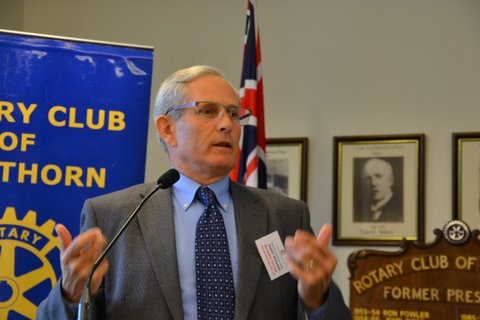Dr Richard Potter ....Energy Efficient Homes
Posted
on Feb 17, 2015
 |
 |
Chairman John Carre-Riddlell in his introduction to guest speaker Dr Richard Potter, a dedicated proponent for not only solar energy but generally the efficient use of energy, reminded us of that famous quote often attributed to Mark Twain or colleague. "Every one complains about the weather but no one does anything about it". Such a charge could not be levied at Richard.
Initially a Senior Research Scientist at ARCO Solar in California USA and, since returning to Australia 20 years ago, Richard has been a leader in the development of Australian solar system design, installation and product development. He is an active member of both the EL-42 Australian Standards Committee for Renewable Energy and the Clean Energy Council.
At the personal level Richard's dedication and commitment to Renewable Energy is exemplified by his own home. It is one of the most energy efficient homes in Australia utilizing solar electricity, solar hot water, energy efficient design and rainwater capture. This home has won four state and national awards of which Richard is proud.
At the personal level Richard's dedication and commitment to Renewable Energy is exemplified by his own home. It is one of the most energy efficient homes in Australia utilizing solar electricity, solar hot water, energy efficient design and rainwater capture. This home has won four state and national awards of which Richard is proud.
Richards address took us through how the energy efficient home embraces and optimizes the interaction of many factors. In sequence he explained them.
The prime "Solar Efficient Design" contemplates a buildings orientation to the sun, weather and local geography of its site, whereas the choice of building materials employed and in which part of a building these are used to complement that.
We heard of "Thermal Mass" that attribute of matter to absorb heat and maintain temperature. Of course the role of Solar Energy to produce electricity is crucial albeit temporal variations across the year or even a day must be managed. A simple but most controllable factor is the use of energy efficient lighting--LED devices now offer enormous savings in energy and costs are declining. Solar hot water systems, double glazing of windows, prudent ventilation coupled with and minimization of auxiliary heating and cooling all impact.
Richard demonstrated with graphical data, anecdotes, and photographs of his own home how all the these features can be architecturally and sensitively balanced in a building and produce a very attractive house.
Question time was great. The receptive audience quickly overran its time as Richard responded clearly and objectively to a host of questions for more information. A key one was the monetary cost beyond that incurred in a standard house. Clearly there was some significant up front premium but long term paybacks were available and improving especially if such energy saving actions were employed at the inception of construction. It was easy to picture future communities, at least in the developed world, routinely centred on these energy efficient practices.
 Ed {One wonders if Twain's quip "If you don't like the weather in New England, just wait a few minutes" was Melbourne inspired?}
Ed {One wonders if Twain's quip "If you don't like the weather in New England, just wait a few minutes" was Melbourne inspired?}